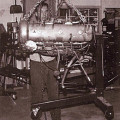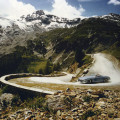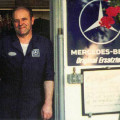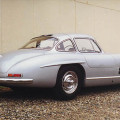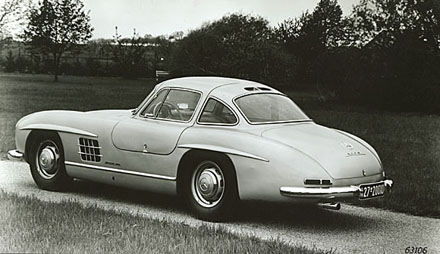 The 1954 300SL Prototype is an icon, and the year 1955 was magical for Daimler-Benz, never to be equaled by any other marque. Their teams won four championships: the Formula One championship with Fangio driving, the World Sports Car Championship with Moss, Fangio, and Kling; an SCCA Championship with Paul O’Shea, and the World Rally Championship with Werner Engel. Of these four simultaneous successes, the latter remains the least known. This 300SL, chassis 8627198071/7, is the car that Engel drove to the 1955 World Rally Championship.Unusual Mercedes-Benz cars often have wonderful stories to tell, but unlocking their past can be difficult. Often the only existing documents are notes in workshop notebooks made years ago by the people who designed and built the cars. Because such cars were handmade, sometimes the first of their kind, they often have unusual features. The Engel 300SL began life as a pre-production prototype, hand built by the experimental department engineers and craftsmen in 1953 and early 1954 as a design exercise to determine the final configuration of the later production 300SL.Daimler-Benz was not in the habit of wasting their racing or experimental cars. It was common for race or experimental cars to be used later for other purposes or even sold. At least three of the 1952 W194 300SL racers were later modified and eventually left the factory for private hands. This example was transformed from experimental prototype to works racer to daily driver!
The 1954 300SL Prototype is an icon, and the year 1955 was magical for Daimler-Benz, never to be equaled by any other marque. Their teams won four championships: the Formula One championship with Fangio driving, the World Sports Car Championship with Moss, Fangio, and Kling; an SCCA Championship with Paul O’Shea, and the World Rally Championship with Werner Engel. Of these four simultaneous successes, the latter remains the least known. This 300SL, chassis 8627198071/7, is the car that Engel drove to the 1955 World Rally Championship.Unusual Mercedes-Benz cars often have wonderful stories to tell, but unlocking their past can be difficult. Often the only existing documents are notes in workshop notebooks made years ago by the people who designed and built the cars. Because such cars were handmade, sometimes the first of their kind, they often have unusual features. The Engel 300SL began life as a pre-production prototype, hand built by the experimental department engineers and craftsmen in 1953 and early 1954 as a design exercise to determine the final configuration of the later production 300SL.Daimler-Benz was not in the habit of wasting their racing or experimental cars. It was common for race or experimental cars to be used later for other purposes or even sold. At least three of the 1952 W194 300SL racers were later modified and eventually left the factory for private hands. This example was transformed from experimental prototype to works racer to daily driver!
Unlike Ferraris, for example, very few special Mercedes-Benz road cars were ever created. This one was built alongside the W196R Grand Prix and the W196S SLR race cars. Its chassis number, beginning with the code 8627, ties it to the racing department. The W196 racers that won the World Sports Car and Formula One Championship in 1955 share the same 8627 designation.
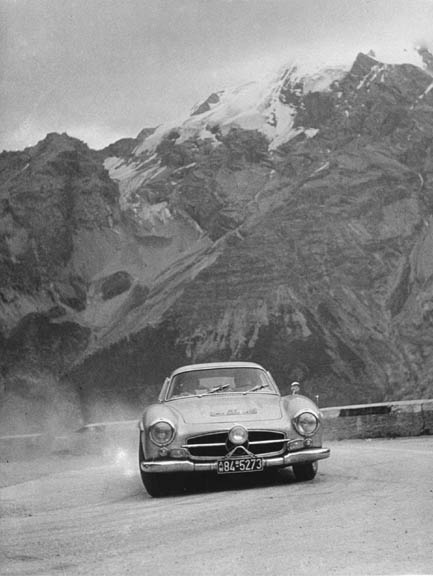
Distinguishing Features
After its life as a development vehicle, the car was used for promotion and display. At one time it was the only 300SL that Daimler-Benz AG had to photograph or display, so it is pictured in early 300SL promotional literature, where it is easily recognizable by its unique push-button door openers.
As a prototype, this 300SL enjoys unique features not found on subsequent production cars. The special racing seats have louvered backrest panels. The unusual steering wheel—black, not ivory as in production cars—does not unlatch and pivot like a production car’s wheel and has a one-half-inch wide white plastic horn button. A clock is fitted atop the dash, which is bounded by wide windshield pillars. The roof vents are different, too, and a lower, fatter transmission tunnel has a storage recess for drink bottles and maps. The interior is clean, lacking the many chrome-plated screws of the production car. The center headliner panel attaches with four screws instead of six, and a small recess in the panels under the doors facilitates their opening. The interior grab handles are upholstered instead of chrome-plated.
Besides the competition springs and shock absorbers, myriad other hardware, inner body structure, and finish panels differ from those of the production model. An experimental heating/ventilation system with large polished circular four-inch aluminum floor ducts directs heat to the footwells. In their initial configuration, the doors had over-center locking hinges which held them open in the same manner as the 1952 race cars, functional but somewhat crude. Trying to pull down a door without unlocking the hinges could substantially damage them. In the second version the over-center hinges were replaced by a torsion bar assembly to support the open door. The final solution was to use four spring-loaded door “shocks”.
When we removed this car’s body for restoration, we discovered that its chassis was uniquely configured. Its side members, nine inches lower than those of the 300SL coupe, were almost identical to those of the production 1957 300SL Roadster. The high side members, which strengthen the chassis, are the reason that these cars have gullwing-type doors.
So why the lower side members on this car?
That question remained unanswered until I received an unexpected call from Werner Engel’s son Matthias, who told me a bit about his father and sent some of the photographs used here. His father’s notes mentioned this special chassis. The additional space beneath the doorsills was created to accommodate auxiliary fuel tanks. In the mid-1950s it could be difficult to get good fuel during long-distance rallies in some parts of Europe, so auxiliary fuel tanks offered a big advantage.
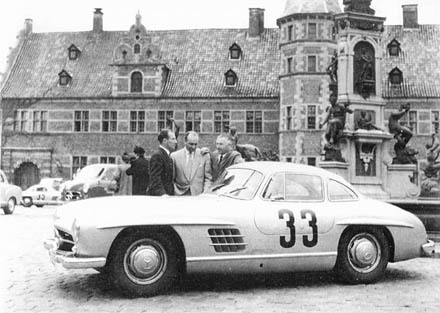
Family Effort
For Werner Engel, racing and rallying were a family affair. Werner began racing in the 1930s driving a BMW 328, and after the war he drove Porsches before this Mercedes-Benz.His family’s publishing business in Hamburg allowed him to pursue motorsport as a true amateur, a “gentleman racer”. Engel’s wife would even follow the racers in a dark blue 220S sedan filled with spare parts, with one of her girlfriends for company.
Engel was a close friend of Alfred Neubauer and Karl Kling, and Wolfgang Von Trips and Juan Manuel Fangio became Matthias’ godfathers. After winning the 1955 World Rally Championship, Werner was awarded the Silver Victory Wreath, the highest sport award given by the German government. Porsche racing boss Richard von Frankenberg presented it to him at a special ceremony (the honor is still given, though Michael Schumacher has yet to win it). Tragically, Werner was killed in a 300SL Roadster immediately after winning the 1957 Tulip Rally in Holland.
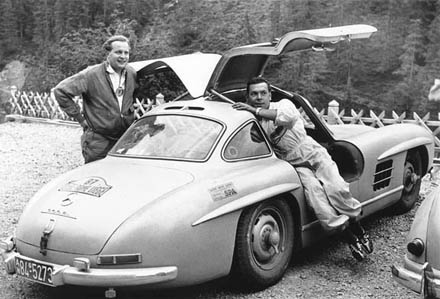
Mille Miglia Practice Car
As an experimental vehicle, this 300SL underwent an evolution of changes as Daimler-Benz used it to test new ideas and features. It became the transition between the W194 race car of 1952 and the eventual production 300SL, the W198, of 1954.
In early 1955 the car was updated from a prototype to a more standard configuration for rally, and race use. As a works racer it was lent to various drivers during the 1955 season. Engel used it to accumulate enough points to win the Rally Championship that year, and Karl Kling drove it to victory in the Swedish Grand Prix, then still a sports car race.
Stirling Moss used the car as his practice vehicle for the Mille Miglia. This was one of Moss’s first drives for legendary team manager Alfred Neubauer, and it almost ended his Mercedes Benz career before it started. Neubauer was upset when the young British driver wrecked the right front fender, puffing the car out of commission. Neubauer got over it, and thanks partly to careful preparation and practice, Moss and his navigator Denis Jenkinson went on to win the Mille Miglia that year in a 300SLR
The factory continued to use this prototype 300SL for testing until 1957. By then the 300SL Roadster seemed to be the model’s last iteration, so this car was sold to Tutor Wilder in the United States.
Midwest History
Wilder was the president of Collins Radio, a respected electronics manufacturer. Since Collins was associated with Studebaker-Packard, the U.S. distributor of Mercedes-Benz cars, this special 300SL became available to Wilder. Because of his interest in the unusual car, most of its racing features were left intact. His godson, Dennis Holloway, fondly remembers many trips in the 300SL and his godfather’s excitement about this special car. When it arrived in the U.S., Wilder drove it from the port of entry, New Orleans, to his home in Cedar Rapids, Iowa. Daimler-Benz provided two engines with it, number 4500001 (the first production M198 engine) and a spare. Wilder used the car almost daily, in all kinds of weather, and in 1960 it was repainted bright yellow. Eventually, in 1976, it was sold for $3,500 to Harvey Lewis, who soon sold it to Lothar Hoess.
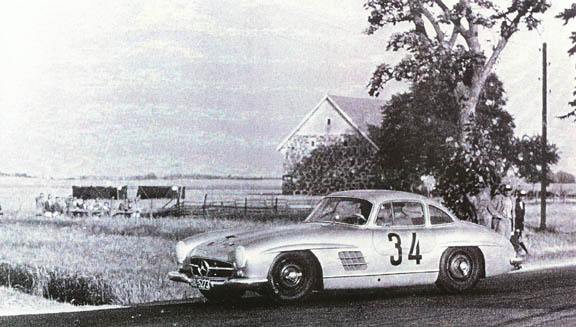 In 1989, Hoess told me that he had an unusual 300SL that he would like me to inspect and perhaps restore. He mentioned that along with its other uncommon features it had an unusual chassis number. Production 300SL chassis numbers begin with the numbers 198, but he said his car’s chassis number began with 8627. Since I had restored the 300SLS Roadster prototype (see our September/October 1991 issue), which had a similar number, I could identify his car as another preproduction prototype! The numbers 8627 served as an accounting “cost code” to identify it as a racing department project.
In 1989, Hoess told me that he had an unusual 300SL that he would like me to inspect and perhaps restore. He mentioned that along with its other uncommon features it had an unusual chassis number. Production 300SL chassis numbers begin with the numbers 198, but he said his car’s chassis number began with 8627. Since I had restored the 300SLS Roadster prototype (see our September/October 1991 issue), which had a similar number, I could identify his car as another preproduction prototype! The numbers 8627 served as an accounting “cost code” to identify it as a racing department project.
Still, we knew nothing of the car’s history other than that it was a pre-production model. Identifying special Mercedes-Benz cars can be difficult. Specific records weren’t always kept on test and competition vehicles. Rudolf Uhlenhaut once explained this as being tied to the mentality pervading Germany after World War 11. DBAG had survived a devastating war, and its workers were literally digging themselves out of the rubble. People were looking to the future, not the past. There was little emphasis on record keeping, especially organizing records or data. Even today the lack of effective cross-references between historic information and photos complicates research. It is difficult to research a specific feature or to trace prototypes because they underwent so many body and chassis changes and occasionally even got new identification numbers. DBAG built as few prototypes as possible but continually changed them. For instance, before being sold to Wilder, this prototype went through at least three major body modifications.
Restoration
Hoess decided not to proceed with a restoration, then in 1990 I sold Scott Restorations and moved from Los Angeles to Kalamazoo, Michigan. This 300SL disappeared from my thoughts until 1995, when I got a call from Lothar, who was again considering what to do. He decided to sell the car, and I put him in touch with Robert Meyer of Newport Beach, California. They struck a deal, and the car was shipped to me in Michigan to begin restoration.
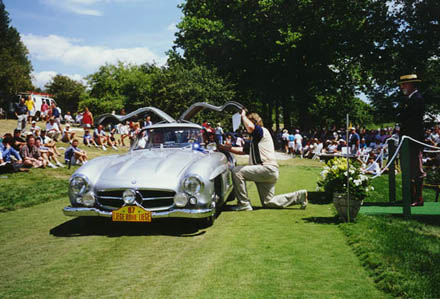
Thus began one of the most difficult restorations I have ever attempted. The most obvious difficulty was the car’s condition, but it would be difficult to unlock its past. When it arrived at our shop, the car was assembled and running, but unfortunately it had suffered the cumulative effects of long, hard use. I feel strongly that any restorer must try to save as much of an original car as possible, especially if the car may be historically significant. We made every effort to repair many damaged pieces that for the sake of economy probably should have been re-created or replaced.
Which of its three versions should this 300SL be configured as? Should it be to its first form, the prototype coupe with the push-button doors? The decision was made to restore it as the 1955 works racer, which was essentially what we had minus the rally equipment. During my research I found a series of wonderful photographs by Kurt Worner. Made for Road & Track during the 1955 Liege-Rome-Liege Rally, they showed Werner Engel and the car with co-driver and mechanic Roger Staub, who was on loan to him along with the car from DBAG. The license number in the photographs helped identify the car in other photographs, and little by little we pieced together its history.
In the vendor area at the 1999 Monterey historic races, I was looking through a tent that had rally plates hanging from a rope strung between the tent poles. Two original 1955 Liege-Rome-Liege Rally plates caught my attention, and I almost fell over when I realized that one was the actual number 87 plate from Engel’s 300SL! After haggling with the vendor, I bought the plate and reunited it with the car.
In a way, one car is pretty much like another— an amalgam of metal, glass, fabric, and rubber. Each model of car is, of course, different in style and engineering, special from others. But for me, by far the most interesting part of any individual car is its history: where it’s been, who used it, and the stories that they might tell.
